Business Environment Analysis: Stakeholders, Factors, and Strategy
VerifiedAdded on 2020/07/22
|12
|3118
|43
Report
AI Summary
This report provides a comprehensive analysis of the business environment, exploring the interplay of internal and external factors that influence organizational productivity. The report begins by defining different types of businesses (sole trader, partnership, limited company, franchise) and their purposes, ownership structures and contrasting these. It then examines the roles and viewpoints of various stakeholders, including owners, managers, employees, customers, and suppliers, and how they influence the aims and objectives of a business. The organizational structure of businesses and how these structures help to fulfill their purposes are described. The report further delves into the impact of economic environments on business activities, comparing the challenges faced in different economic contexts. Finally, the report assesses the influence of political, legal, and social factors on business operations and how these factors may impact on future strategies.
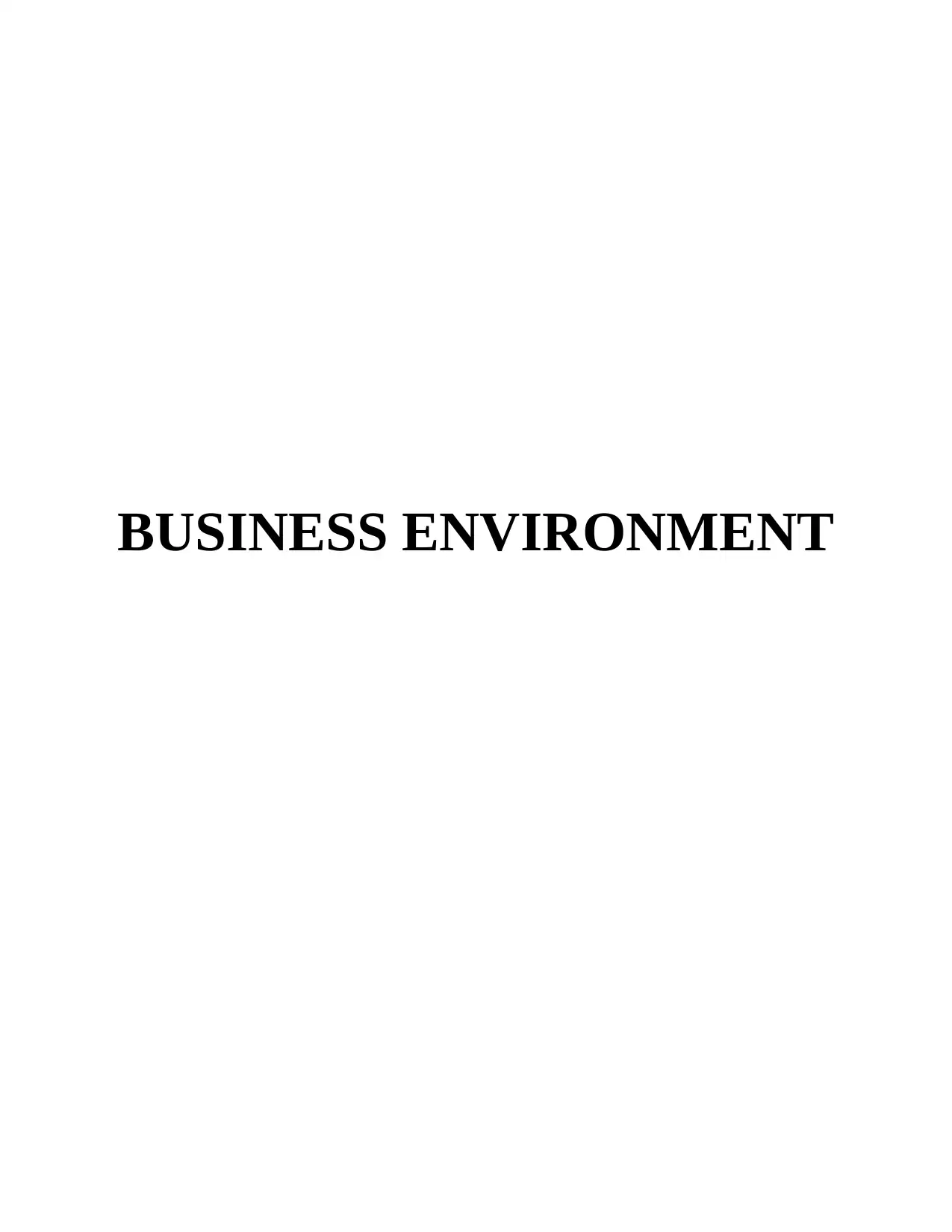
BUSINESS ENVIRONMENT
Paraphrase This Document
Need a fresh take? Get an instant paraphrase of this document with our AI Paraphraser
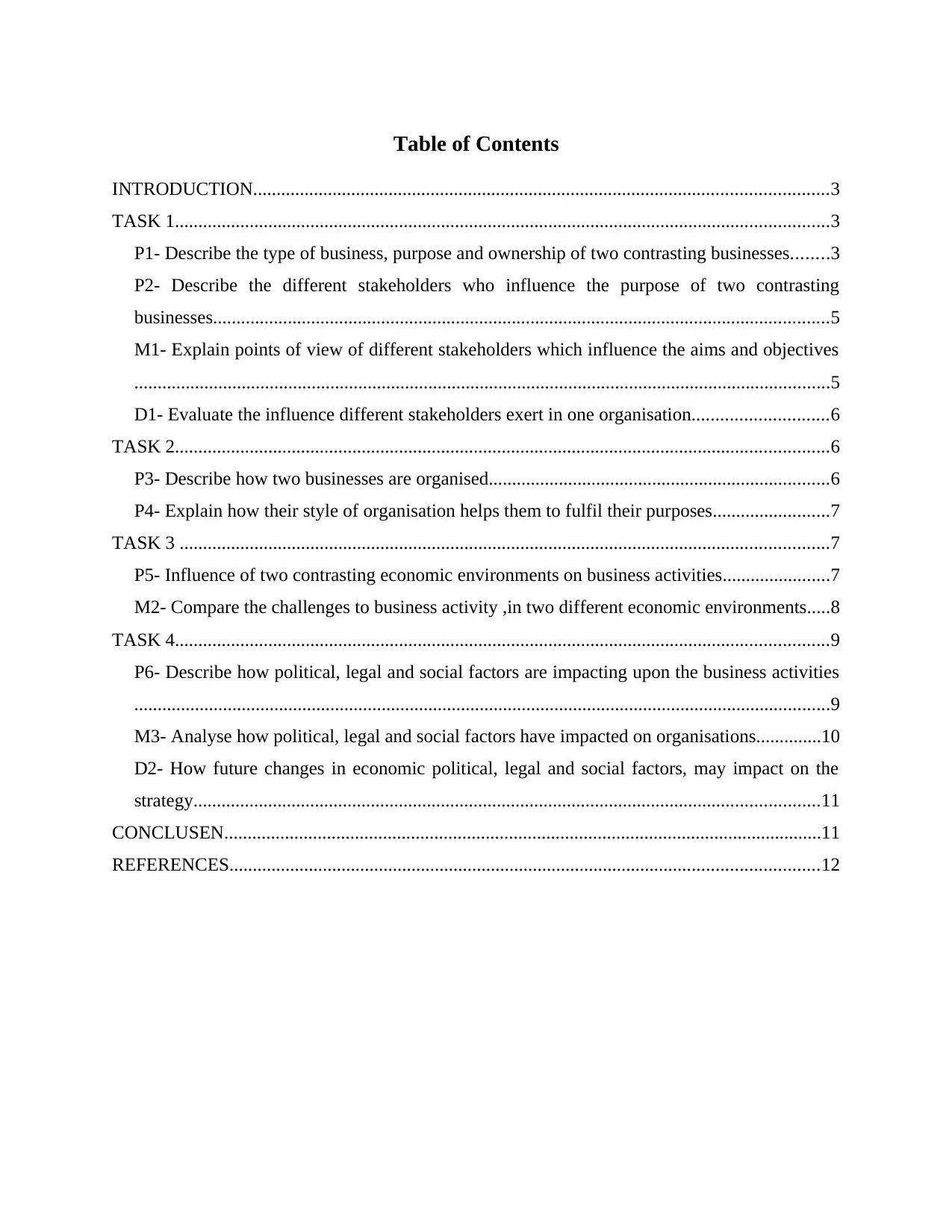
Table of Contents
INTRODUCTION...........................................................................................................................3
TASK 1............................................................................................................................................3
P1- Describe the type of business, purpose and ownership of two contrasting businesses........3
P2- Describe the different stakeholders who influence the purpose of two contrasting
businesses....................................................................................................................................5
M1- Explain points of view of different stakeholders which influence the aims and objectives
.....................................................................................................................................................5
D1- Evaluate the influence different stakeholders exert in one organisation.............................6
TASK 2............................................................................................................................................6
P3- Describe how two businesses are organised.........................................................................6
P4- Explain how their style of organisation helps them to fulfil their purposes.........................7
TASK 3 ...........................................................................................................................................7
P5- Influence of two contrasting economic environments on business activities.......................7
M2- Compare the challenges to business activity ,in two different economic environments.....8
TASK 4............................................................................................................................................9
P6- Describe how political, legal and social factors are impacting upon the business activities
.....................................................................................................................................................9
M3- Analyse how political, legal and social factors have impacted on organisations..............10
D2- How future changes in economic political, legal and social factors, may impact on the
strategy......................................................................................................................................11
CONCLUSEN................................................................................................................................11
REFERENCES..............................................................................................................................12
INTRODUCTION...........................................................................................................................3
TASK 1............................................................................................................................................3
P1- Describe the type of business, purpose and ownership of two contrasting businesses........3
P2- Describe the different stakeholders who influence the purpose of two contrasting
businesses....................................................................................................................................5
M1- Explain points of view of different stakeholders which influence the aims and objectives
.....................................................................................................................................................5
D1- Evaluate the influence different stakeholders exert in one organisation.............................6
TASK 2............................................................................................................................................6
P3- Describe how two businesses are organised.........................................................................6
P4- Explain how their style of organisation helps them to fulfil their purposes.........................7
TASK 3 ...........................................................................................................................................7
P5- Influence of two contrasting economic environments on business activities.......................7
M2- Compare the challenges to business activity ,in two different economic environments.....8
TASK 4............................................................................................................................................9
P6- Describe how political, legal and social factors are impacting upon the business activities
.....................................................................................................................................................9
M3- Analyse how political, legal and social factors have impacted on organisations..............10
D2- How future changes in economic political, legal and social factors, may impact on the
strategy......................................................................................................................................11
CONCLUSEN................................................................................................................................11
REFERENCES..............................................................................................................................12
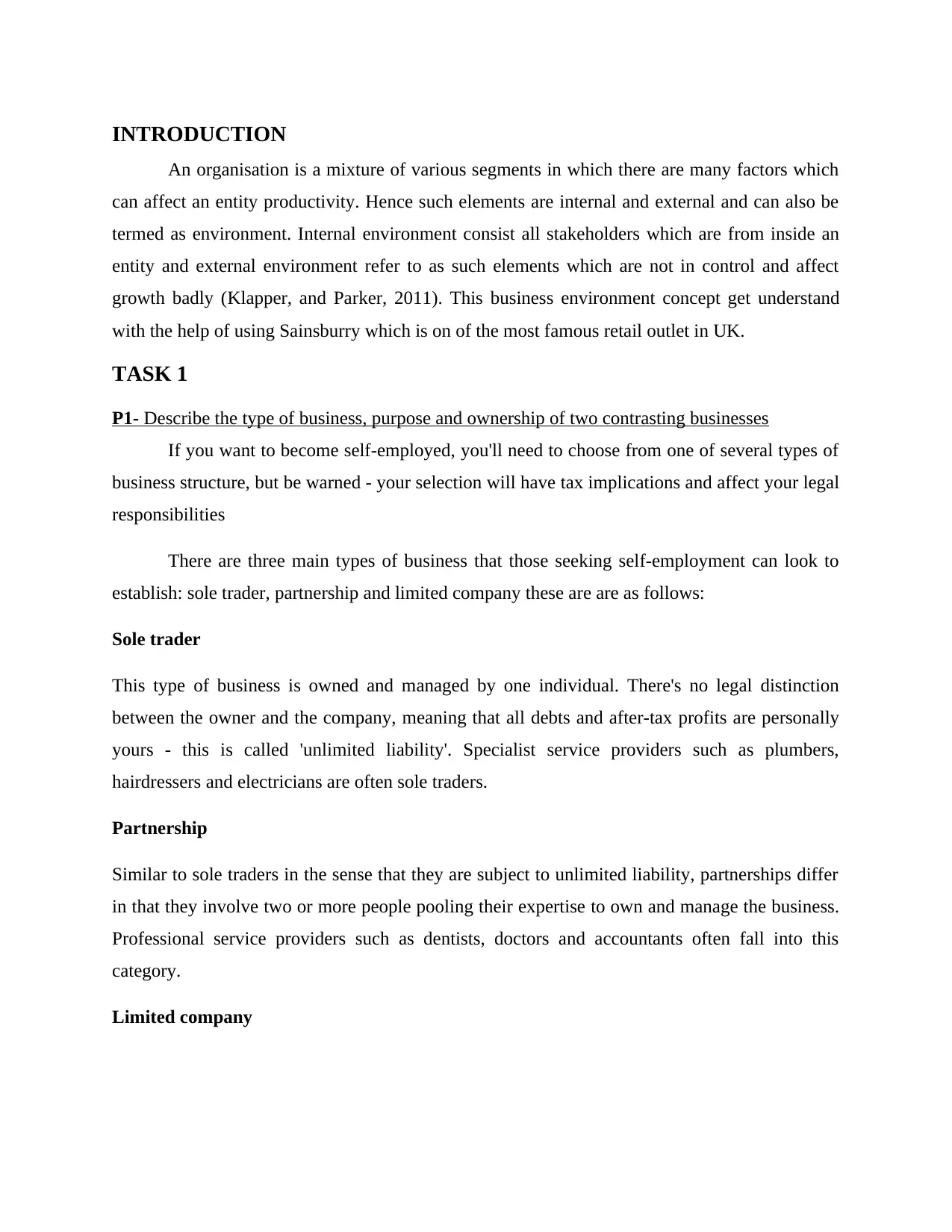
INTRODUCTION
An organisation is a mixture of various segments in which there are many factors which
can affect an entity productivity. Hence such elements are internal and external and can also be
termed as environment. Internal environment consist all stakeholders which are from inside an
entity and external environment refer to as such elements which are not in control and affect
growth badly (Klapper, and Parker, 2011). This business environment concept get understand
with the help of using Sainsburry which is on of the most famous retail outlet in UK.
TASK 1
P1- Describe the type of business, purpose and ownership of two contrasting businesses
If you want to become self-employed, you'll need to choose from one of several types of
business structure, but be warned - your selection will have tax implications and affect your legal
responsibilities
There are three main types of business that those seeking self-employment can look to
establish: sole trader, partnership and limited company these are are as follows:
Sole trader
This type of business is owned and managed by one individual. There's no legal distinction
between the owner and the company, meaning that all debts and after-tax profits are personally
yours - this is called 'unlimited liability'. Specialist service providers such as plumbers,
hairdressers and electricians are often sole traders.
Partnership
Similar to sole traders in the sense that they are subject to unlimited liability, partnerships differ
in that they involve two or more people pooling their expertise to own and manage the business.
Professional service providers such as dentists, doctors and accountants often fall into this
category.
Limited company
An organisation is a mixture of various segments in which there are many factors which
can affect an entity productivity. Hence such elements are internal and external and can also be
termed as environment. Internal environment consist all stakeholders which are from inside an
entity and external environment refer to as such elements which are not in control and affect
growth badly (Klapper, and Parker, 2011). This business environment concept get understand
with the help of using Sainsburry which is on of the most famous retail outlet in UK.
TASK 1
P1- Describe the type of business, purpose and ownership of two contrasting businesses
If you want to become self-employed, you'll need to choose from one of several types of
business structure, but be warned - your selection will have tax implications and affect your legal
responsibilities
There are three main types of business that those seeking self-employment can look to
establish: sole trader, partnership and limited company these are are as follows:
Sole trader
This type of business is owned and managed by one individual. There's no legal distinction
between the owner and the company, meaning that all debts and after-tax profits are personally
yours - this is called 'unlimited liability'. Specialist service providers such as plumbers,
hairdressers and electricians are often sole traders.
Partnership
Similar to sole traders in the sense that they are subject to unlimited liability, partnerships differ
in that they involve two or more people pooling their expertise to own and manage the business.
Professional service providers such as dentists, doctors and accountants often fall into this
category.
Limited company
⊘ This is a preview!⊘
Do you want full access?
Subscribe today to unlock all pages.

Trusted by 1+ million students worldwide
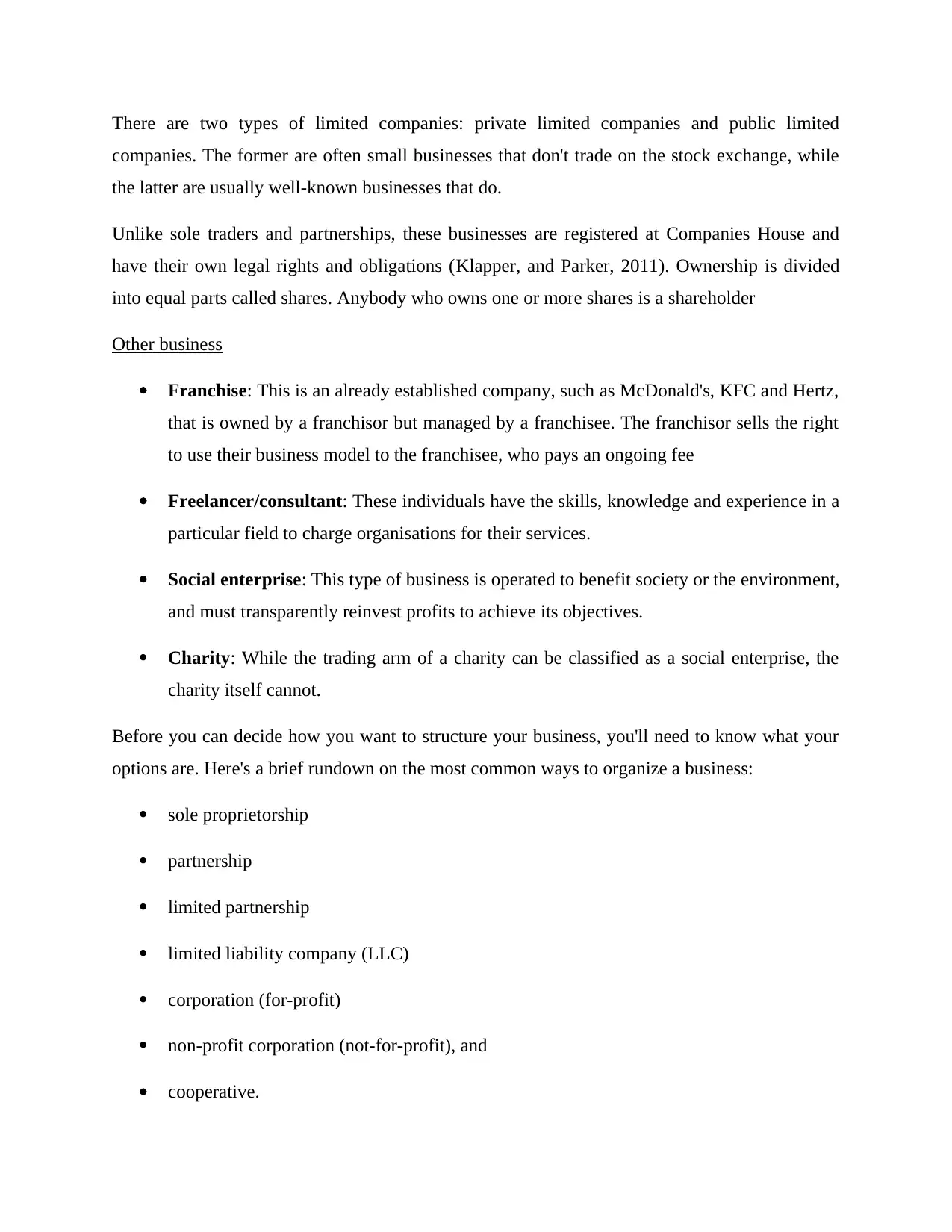
There are two types of limited companies: private limited companies and public limited
companies. The former are often small businesses that don't trade on the stock exchange, while
the latter are usually well-known businesses that do.
Unlike sole traders and partnerships, these businesses are registered at Companies House and
have their own legal rights and obligations (Klapper, and Parker, 2011). Ownership is divided
into equal parts called shares. Anybody who owns one or more shares is a shareholder
Other business
Franchise: This is an already established company, such as McDonald's, KFC and Hertz,
that is owned by a franchisor but managed by a franchisee. The franchisor sells the right
to use their business model to the franchisee, who pays an ongoing fee
Freelancer/consultant: These individuals have the skills, knowledge and experience in a
particular field to charge organisations for their services.
Social enterprise: This type of business is operated to benefit society or the environment,
and must transparently reinvest profits to achieve its objectives.
Charity: While the trading arm of a charity can be classified as a social enterprise, the
charity itself cannot.
Before you can decide how you want to structure your business, you'll need to know what your
options are. Here's a brief rundown on the most common ways to organize a business:
sole proprietorship
partnership
limited partnership
limited liability company (LLC)
corporation (for-profit)
non-profit corporation (not-for-profit), and
cooperative.
companies. The former are often small businesses that don't trade on the stock exchange, while
the latter are usually well-known businesses that do.
Unlike sole traders and partnerships, these businesses are registered at Companies House and
have their own legal rights and obligations (Klapper, and Parker, 2011). Ownership is divided
into equal parts called shares. Anybody who owns one or more shares is a shareholder
Other business
Franchise: This is an already established company, such as McDonald's, KFC and Hertz,
that is owned by a franchisor but managed by a franchisee. The franchisor sells the right
to use their business model to the franchisee, who pays an ongoing fee
Freelancer/consultant: These individuals have the skills, knowledge and experience in a
particular field to charge organisations for their services.
Social enterprise: This type of business is operated to benefit society or the environment,
and must transparently reinvest profits to achieve its objectives.
Charity: While the trading arm of a charity can be classified as a social enterprise, the
charity itself cannot.
Before you can decide how you want to structure your business, you'll need to know what your
options are. Here's a brief rundown on the most common ways to organize a business:
sole proprietorship
partnership
limited partnership
limited liability company (LLC)
corporation (for-profit)
non-profit corporation (not-for-profit), and
cooperative.
Paraphrase This Document
Need a fresh take? Get an instant paraphrase of this document with our AI Paraphraser
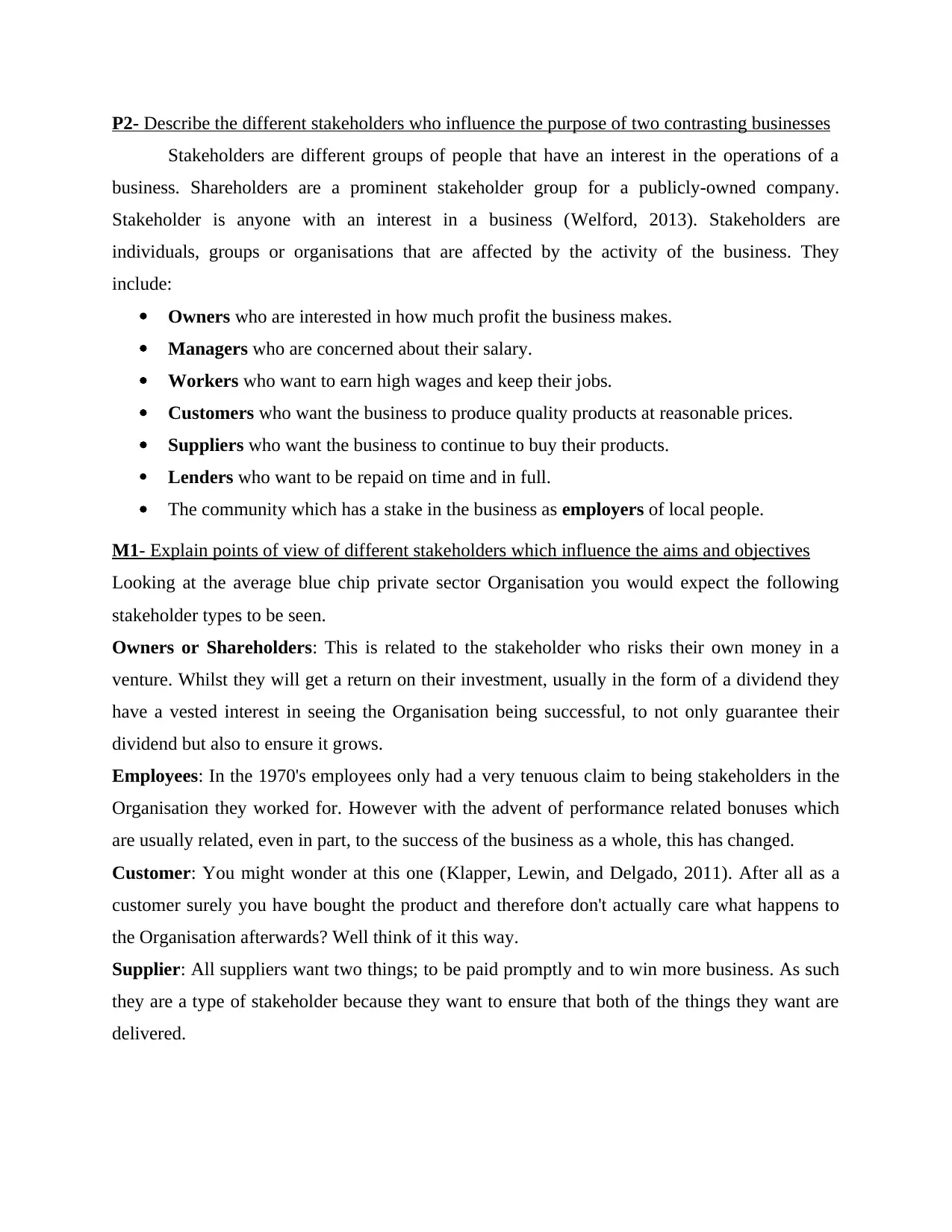
P2- Describe the different stakeholders who influence the purpose of two contrasting businesses
Stakeholders are different groups of people that have an interest in the operations of a
business. Shareholders are a prominent stakeholder group for a publicly-owned company.
Stakeholder is anyone with an interest in a business (Welford, 2013). Stakeholders are
individuals, groups or organisations that are affected by the activity of the business. They
include:
Owners who are interested in how much profit the business makes.
Managers who are concerned about their salary.
Workers who want to earn high wages and keep their jobs.
Customers who want the business to produce quality products at reasonable prices.
Suppliers who want the business to continue to buy their products.
Lenders who want to be repaid on time and in full.
The community which has a stake in the business as employers of local people.
M1- Explain points of view of different stakeholders which influence the aims and objectives
Looking at the average blue chip private sector Organisation you would expect the following
stakeholder types to be seen.
Owners or Shareholders: This is related to the stakeholder who risks their own money in a
venture. Whilst they will get a return on their investment, usually in the form of a dividend they
have a vested interest in seeing the Organisation being successful, to not only guarantee their
dividend but also to ensure it grows.
Employees: In the 1970's employees only had a very tenuous claim to being stakeholders in the
Organisation they worked for. However with the advent of performance related bonuses which
are usually related, even in part, to the success of the business as a whole, this has changed.
Customer: You might wonder at this one (Klapper, Lewin, and Delgado, 2011). After all as a
customer surely you have bought the product and therefore don't actually care what happens to
the Organisation afterwards? Well think of it this way.
Supplier: All suppliers want two things; to be paid promptly and to win more business. As such
they are a type of stakeholder because they want to ensure that both of the things they want are
delivered.
Stakeholders are different groups of people that have an interest in the operations of a
business. Shareholders are a prominent stakeholder group for a publicly-owned company.
Stakeholder is anyone with an interest in a business (Welford, 2013). Stakeholders are
individuals, groups or organisations that are affected by the activity of the business. They
include:
Owners who are interested in how much profit the business makes.
Managers who are concerned about their salary.
Workers who want to earn high wages and keep their jobs.
Customers who want the business to produce quality products at reasonable prices.
Suppliers who want the business to continue to buy their products.
Lenders who want to be repaid on time and in full.
The community which has a stake in the business as employers of local people.
M1- Explain points of view of different stakeholders which influence the aims and objectives
Looking at the average blue chip private sector Organisation you would expect the following
stakeholder types to be seen.
Owners or Shareholders: This is related to the stakeholder who risks their own money in a
venture. Whilst they will get a return on their investment, usually in the form of a dividend they
have a vested interest in seeing the Organisation being successful, to not only guarantee their
dividend but also to ensure it grows.
Employees: In the 1970's employees only had a very tenuous claim to being stakeholders in the
Organisation they worked for. However with the advent of performance related bonuses which
are usually related, even in part, to the success of the business as a whole, this has changed.
Customer: You might wonder at this one (Klapper, Lewin, and Delgado, 2011). After all as a
customer surely you have bought the product and therefore don't actually care what happens to
the Organisation afterwards? Well think of it this way.
Supplier: All suppliers want two things; to be paid promptly and to win more business. As such
they are a type of stakeholder because they want to ensure that both of the things they want are
delivered.
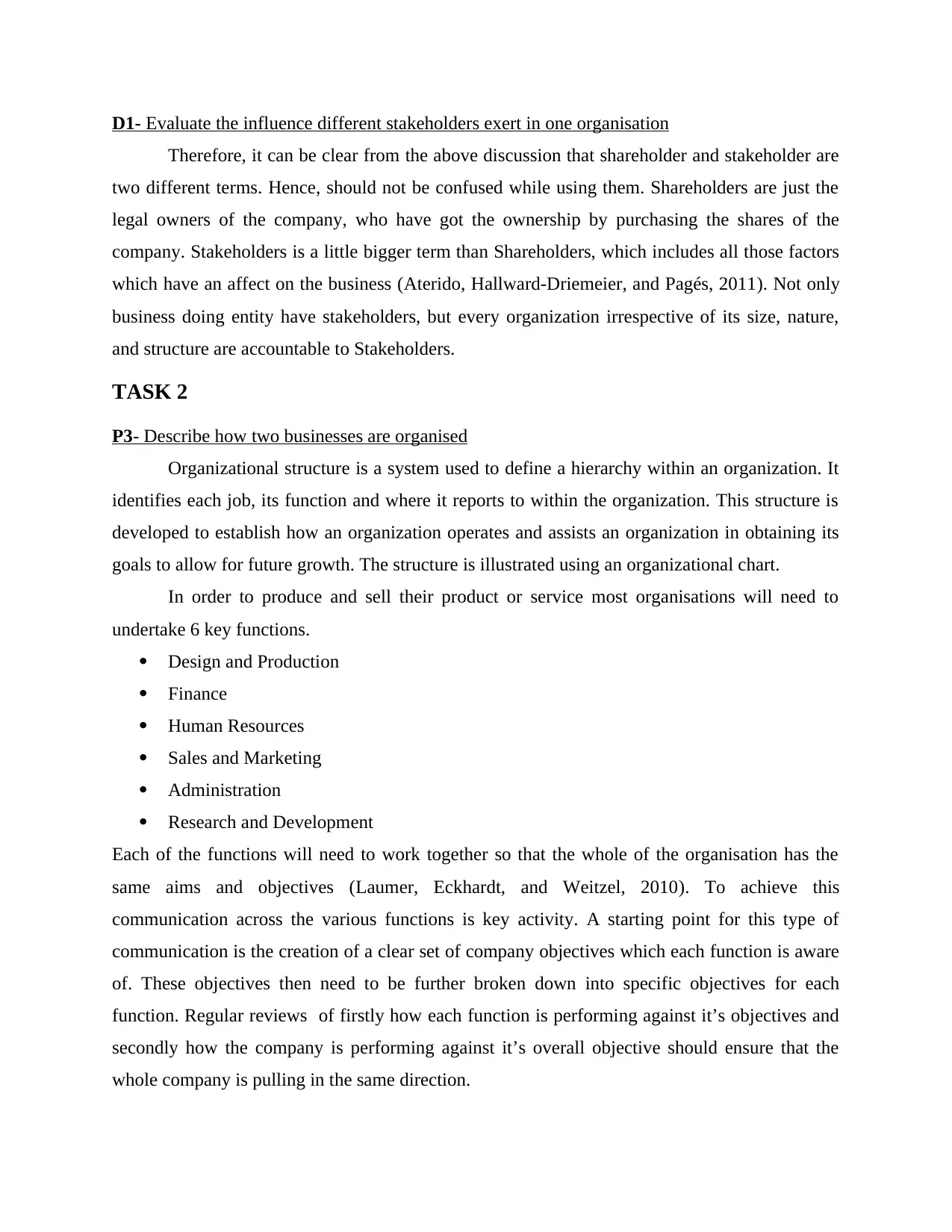
D1- Evaluate the influence different stakeholders exert in one organisation
Therefore, it can be clear from the above discussion that shareholder and stakeholder are
two different terms. Hence, should not be confused while using them. Shareholders are just the
legal owners of the company, who have got the ownership by purchasing the shares of the
company. Stakeholders is a little bigger term than Shareholders, which includes all those factors
which have an affect on the business (Aterido, Hallward-Driemeier, and Pagés, 2011). Not only
business doing entity have stakeholders, but every organization irrespective of its size, nature,
and structure are accountable to Stakeholders.
TASK 2
P3- Describe how two businesses are organised
Organizational structure is a system used to define a hierarchy within an organization. It
identifies each job, its function and where it reports to within the organization. This structure is
developed to establish how an organization operates and assists an organization in obtaining its
goals to allow for future growth. The structure is illustrated using an organizational chart.
In order to produce and sell their product or service most organisations will need to
undertake 6 key functions.
Design and Production
Finance
Human Resources
Sales and Marketing
Administration
Research and Development
Each of the functions will need to work together so that the whole of the organisation has the
same aims and objectives (Laumer, Eckhardt, and Weitzel, 2010). To achieve this
communication across the various functions is key activity. A starting point for this type of
communication is the creation of a clear set of company objectives which each function is aware
of. These objectives then need to be further broken down into specific objectives for each
function. Regular reviews of firstly how each function is performing against it’s objectives and
secondly how the company is performing against it’s overall objective should ensure that the
whole company is pulling in the same direction.
Therefore, it can be clear from the above discussion that shareholder and stakeholder are
two different terms. Hence, should not be confused while using them. Shareholders are just the
legal owners of the company, who have got the ownership by purchasing the shares of the
company. Stakeholders is a little bigger term than Shareholders, which includes all those factors
which have an affect on the business (Aterido, Hallward-Driemeier, and Pagés, 2011). Not only
business doing entity have stakeholders, but every organization irrespective of its size, nature,
and structure are accountable to Stakeholders.
TASK 2
P3- Describe how two businesses are organised
Organizational structure is a system used to define a hierarchy within an organization. It
identifies each job, its function and where it reports to within the organization. This structure is
developed to establish how an organization operates and assists an organization in obtaining its
goals to allow for future growth. The structure is illustrated using an organizational chart.
In order to produce and sell their product or service most organisations will need to
undertake 6 key functions.
Design and Production
Finance
Human Resources
Sales and Marketing
Administration
Research and Development
Each of the functions will need to work together so that the whole of the organisation has the
same aims and objectives (Laumer, Eckhardt, and Weitzel, 2010). To achieve this
communication across the various functions is key activity. A starting point for this type of
communication is the creation of a clear set of company objectives which each function is aware
of. These objectives then need to be further broken down into specific objectives for each
function. Regular reviews of firstly how each function is performing against it’s objectives and
secondly how the company is performing against it’s overall objective should ensure that the
whole company is pulling in the same direction.
⊘ This is a preview!⊘
Do you want full access?
Subscribe today to unlock all pages.

Trusted by 1+ million students worldwide
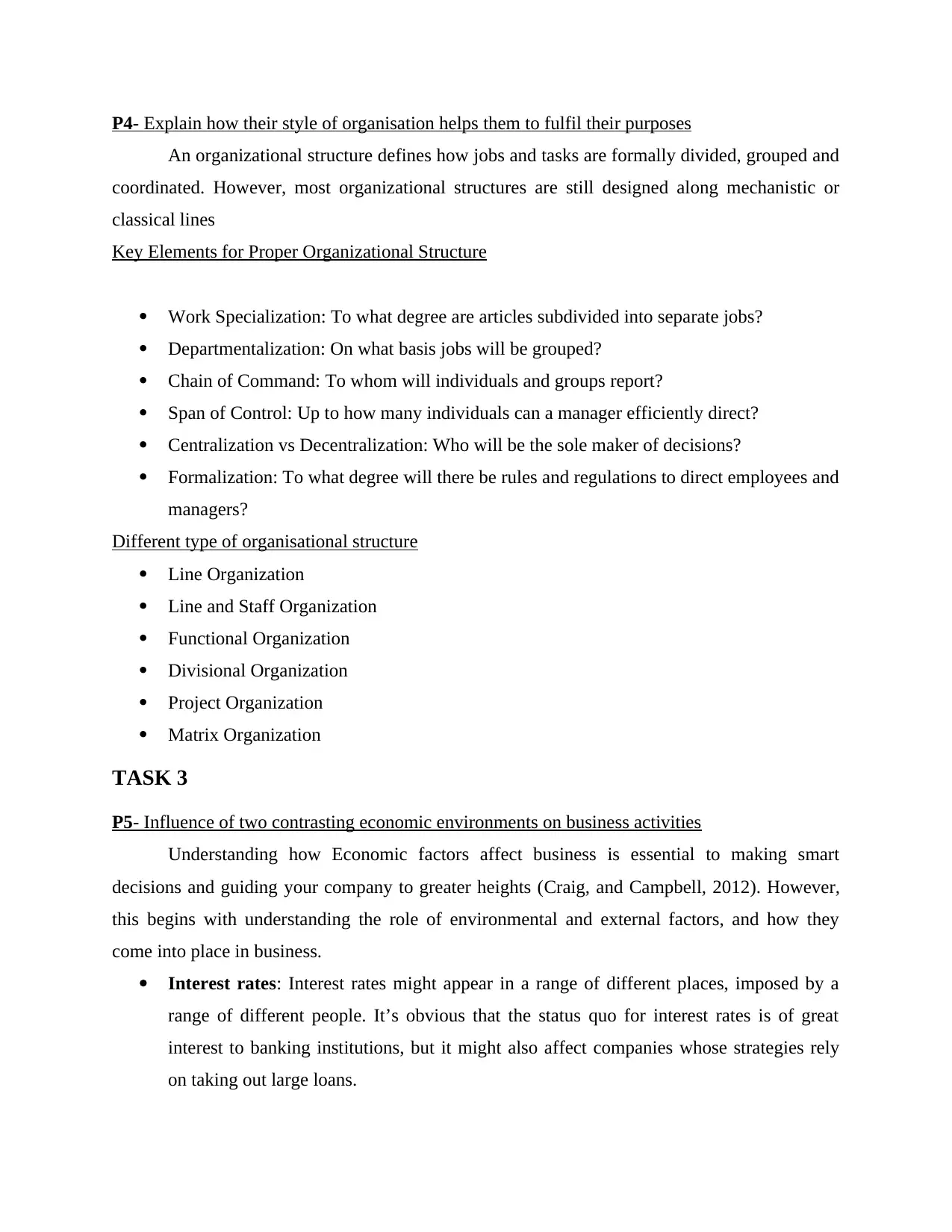
P4- Explain how their style of organisation helps them to fulfil their purposes
An organizational structure defines how jobs and tasks are formally divided, grouped and
coordinated. However, most organizational structures are still designed along mechanistic or
classical lines
Key Elements for Proper Organizational Structure
Work Specialization: To what degree are articles subdivided into separate jobs?
Departmentalization: On what basis jobs will be grouped?
Chain of Command: To whom will individuals and groups report?
Span of Control: Up to how many individuals can a manager efficiently direct?
Centralization vs Decentralization: Who will be the sole maker of decisions?
Formalization: To what degree will there be rules and regulations to direct employees and
managers?
Different type of organisational structure
Line Organization
Line and Staff Organization
Functional Organization
Divisional Organization
Project Organization
Matrix Organization
TASK 3
P5- Influence of two contrasting economic environments on business activities
Understanding how Economic factors affect business is essential to making smart
decisions and guiding your company to greater heights (Craig, and Campbell, 2012). However,
this begins with understanding the role of environmental and external factors, and how they
come into place in business.
Interest rates: Interest rates might appear in a range of different places, imposed by a
range of different people. It’s obvious that the status quo for interest rates is of great
interest to banking institutions, but it might also affect companies whose strategies rely
on taking out large loans.
An organizational structure defines how jobs and tasks are formally divided, grouped and
coordinated. However, most organizational structures are still designed along mechanistic or
classical lines
Key Elements for Proper Organizational Structure
Work Specialization: To what degree are articles subdivided into separate jobs?
Departmentalization: On what basis jobs will be grouped?
Chain of Command: To whom will individuals and groups report?
Span of Control: Up to how many individuals can a manager efficiently direct?
Centralization vs Decentralization: Who will be the sole maker of decisions?
Formalization: To what degree will there be rules and regulations to direct employees and
managers?
Different type of organisational structure
Line Organization
Line and Staff Organization
Functional Organization
Divisional Organization
Project Organization
Matrix Organization
TASK 3
P5- Influence of two contrasting economic environments on business activities
Understanding how Economic factors affect business is essential to making smart
decisions and guiding your company to greater heights (Craig, and Campbell, 2012). However,
this begins with understanding the role of environmental and external factors, and how they
come into place in business.
Interest rates: Interest rates might appear in a range of different places, imposed by a
range of different people. It’s obvious that the status quo for interest rates is of great
interest to banking institutions, but it might also affect companies whose strategies rely
on taking out large loans.
Paraphrase This Document
Need a fresh take? Get an instant paraphrase of this document with our AI Paraphraser
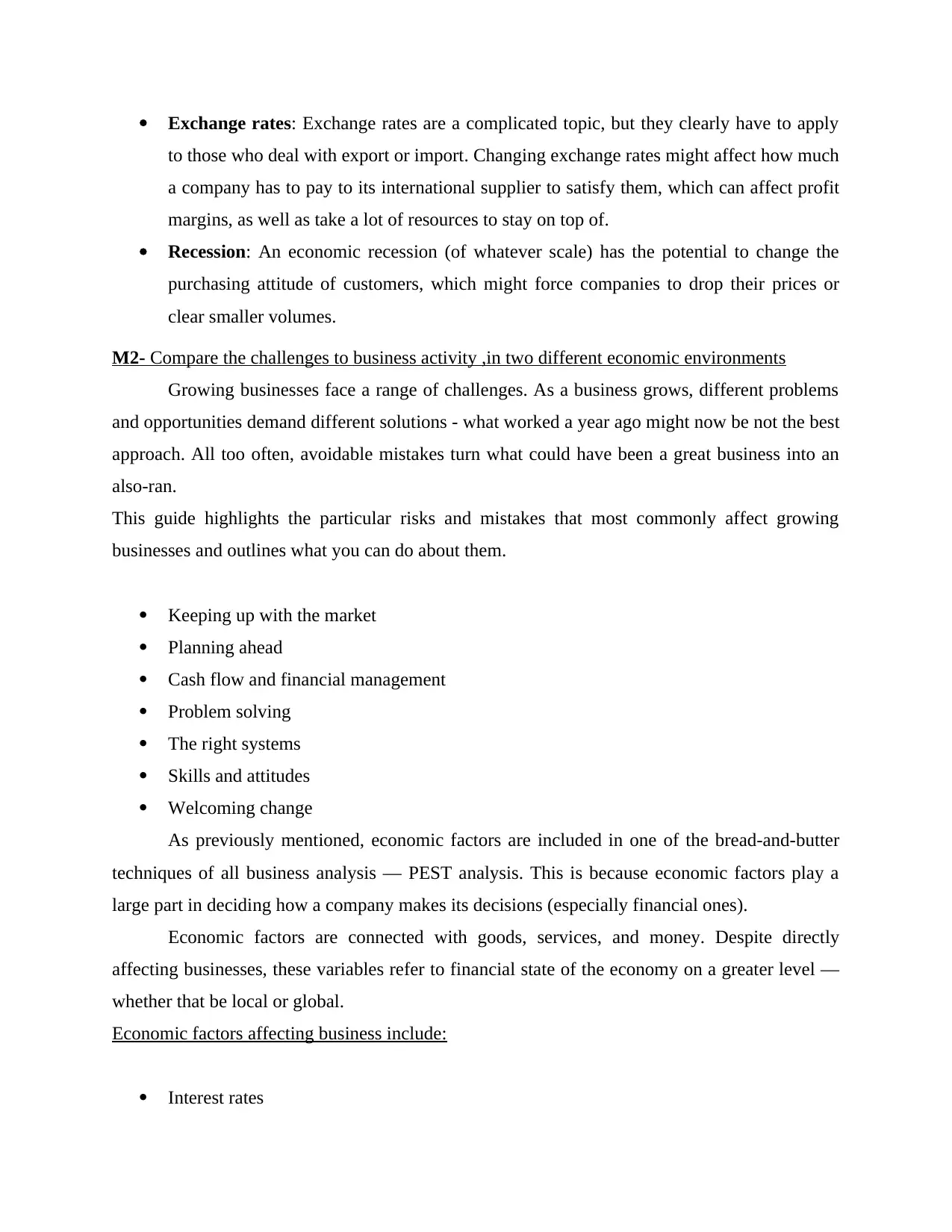
Exchange rates: Exchange rates are a complicated topic, but they clearly have to apply
to those who deal with export or import. Changing exchange rates might affect how much
a company has to pay to its international supplier to satisfy them, which can affect profit
margins, as well as take a lot of resources to stay on top of.
Recession: An economic recession (of whatever scale) has the potential to change the
purchasing attitude of customers, which might force companies to drop their prices or
clear smaller volumes.
M2- Compare the challenges to business activity ,in two different economic environments
Growing businesses face a range of challenges. As a business grows, different problems
and opportunities demand different solutions - what worked a year ago might now be not the best
approach. All too often, avoidable mistakes turn what could have been a great business into an
also-ran.
This guide highlights the particular risks and mistakes that most commonly affect growing
businesses and outlines what you can do about them.
Keeping up with the market
Planning ahead
Cash flow and financial management
Problem solving
The right systems
Skills and attitudes
Welcoming change
As previously mentioned, economic factors are included in one of the bread-and-butter
techniques of all business analysis — PEST analysis. This is because economic factors play a
large part in deciding how a company makes its decisions (especially financial ones).
Economic factors are connected with goods, services, and money. Despite directly
affecting businesses, these variables refer to financial state of the economy on a greater level —
whether that be local or global.
Economic factors affecting business include:
Interest rates
to those who deal with export or import. Changing exchange rates might affect how much
a company has to pay to its international supplier to satisfy them, which can affect profit
margins, as well as take a lot of resources to stay on top of.
Recession: An economic recession (of whatever scale) has the potential to change the
purchasing attitude of customers, which might force companies to drop their prices or
clear smaller volumes.
M2- Compare the challenges to business activity ,in two different economic environments
Growing businesses face a range of challenges. As a business grows, different problems
and opportunities demand different solutions - what worked a year ago might now be not the best
approach. All too often, avoidable mistakes turn what could have been a great business into an
also-ran.
This guide highlights the particular risks and mistakes that most commonly affect growing
businesses and outlines what you can do about them.
Keeping up with the market
Planning ahead
Cash flow and financial management
Problem solving
The right systems
Skills and attitudes
Welcoming change
As previously mentioned, economic factors are included in one of the bread-and-butter
techniques of all business analysis — PEST analysis. This is because economic factors play a
large part in deciding how a company makes its decisions (especially financial ones).
Economic factors are connected with goods, services, and money. Despite directly
affecting businesses, these variables refer to financial state of the economy on a greater level —
whether that be local or global.
Economic factors affecting business include:
Interest rates
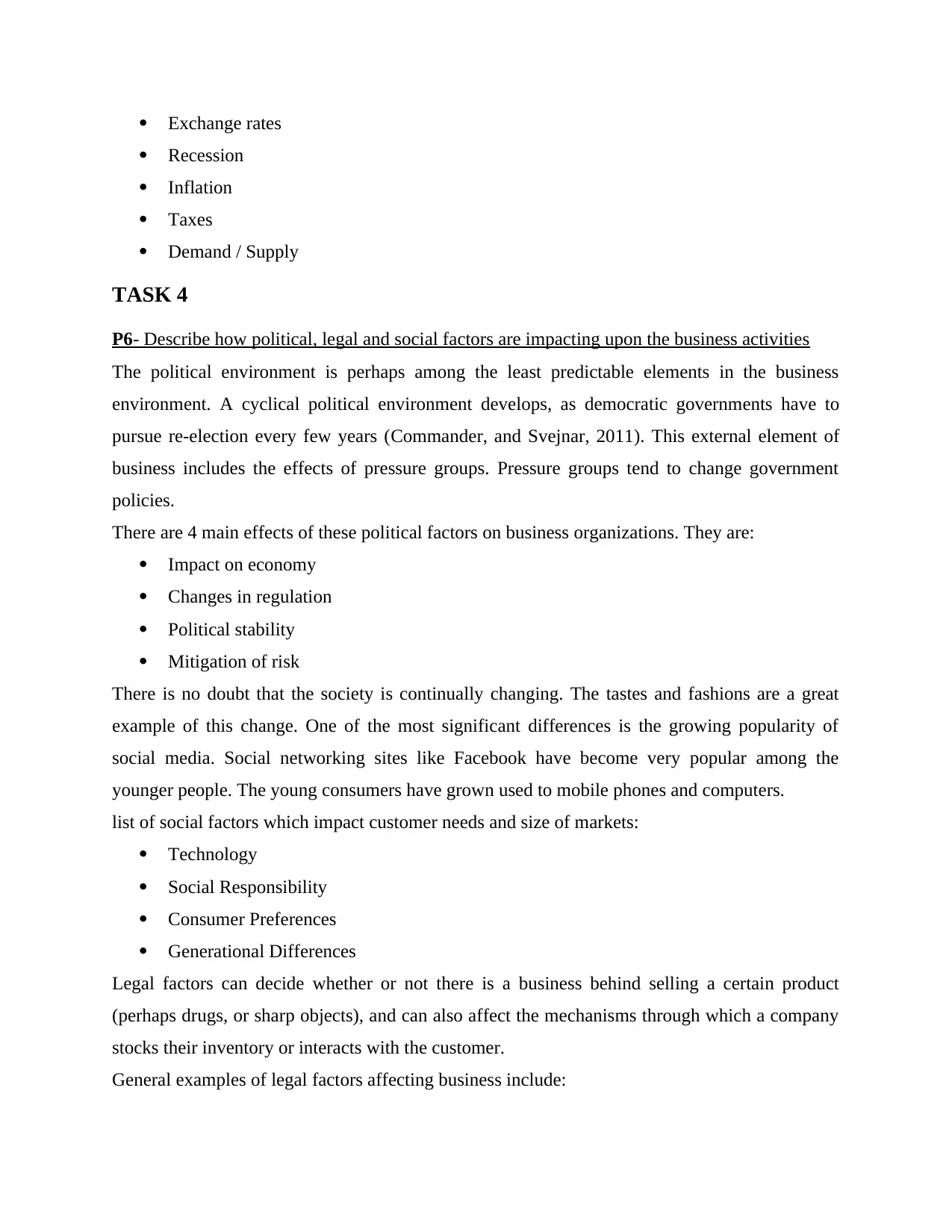
Exchange rates
Recession
Inflation
Taxes
Demand / Supply
TASK 4
P6- Describe how political, legal and social factors are impacting upon the business activities
The political environment is perhaps among the least predictable elements in the business
environment. A cyclical political environment develops, as democratic governments have to
pursue re-election every few years (Commander, and Svejnar, 2011). This external element of
business includes the effects of pressure groups. Pressure groups tend to change government
policies.
There are 4 main effects of these political factors on business organizations. They are:
Impact on economy
Changes in regulation
Political stability
Mitigation of risk
There is no doubt that the society is continually changing. The tastes and fashions are a great
example of this change. One of the most significant differences is the growing popularity of
social media. Social networking sites like Facebook have become very popular among the
younger people. The young consumers have grown used to mobile phones and computers.
list of social factors which impact customer needs and size of markets:
Technology
Social Responsibility
Consumer Preferences
Generational Differences
Legal factors can decide whether or not there is a business behind selling a certain product
(perhaps drugs, or sharp objects), and can also affect the mechanisms through which a company
stocks their inventory or interacts with the customer.
General examples of legal factors affecting business include:
Recession
Inflation
Taxes
Demand / Supply
TASK 4
P6- Describe how political, legal and social factors are impacting upon the business activities
The political environment is perhaps among the least predictable elements in the business
environment. A cyclical political environment develops, as democratic governments have to
pursue re-election every few years (Commander, and Svejnar, 2011). This external element of
business includes the effects of pressure groups. Pressure groups tend to change government
policies.
There are 4 main effects of these political factors on business organizations. They are:
Impact on economy
Changes in regulation
Political stability
Mitigation of risk
There is no doubt that the society is continually changing. The tastes and fashions are a great
example of this change. One of the most significant differences is the growing popularity of
social media. Social networking sites like Facebook have become very popular among the
younger people. The young consumers have grown used to mobile phones and computers.
list of social factors which impact customer needs and size of markets:
Technology
Social Responsibility
Consumer Preferences
Generational Differences
Legal factors can decide whether or not there is a business behind selling a certain product
(perhaps drugs, or sharp objects), and can also affect the mechanisms through which a company
stocks their inventory or interacts with the customer.
General examples of legal factors affecting business include:
⊘ This is a preview!⊘
Do you want full access?
Subscribe today to unlock all pages.

Trusted by 1+ million students worldwide
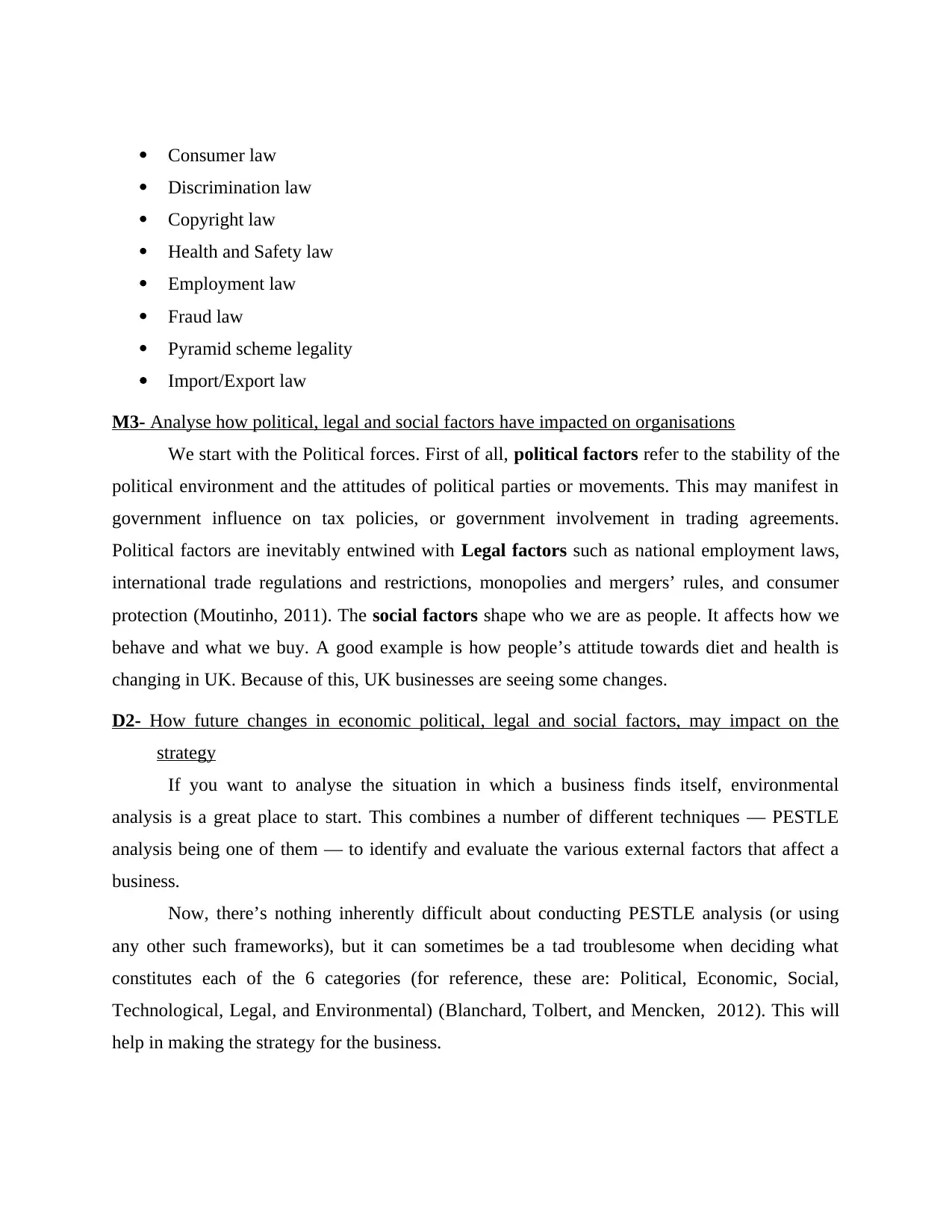
Consumer law
Discrimination law
Copyright law
Health and Safety law
Employment law
Fraud law
Pyramid scheme legality
Import/Export law
M3- Analyse how political, legal and social factors have impacted on organisations
We start with the Political forces. First of all, political factors refer to the stability of the
political environment and the attitudes of political parties or movements. This may manifest in
government influence on tax policies, or government involvement in trading agreements.
Political factors are inevitably entwined with Legal factors such as national employment laws,
international trade regulations and restrictions, monopolies and mergers’ rules, and consumer
protection (Moutinho, 2011). The social factors shape who we are as people. It affects how we
behave and what we buy. A good example is how people’s attitude towards diet and health is
changing in UK. Because of this, UK businesses are seeing some changes.
D2- How future changes in economic political, legal and social factors, may impact on the
strategy
If you want to analyse the situation in which a business finds itself, environmental
analysis is a great place to start. This combines a number of different techniques — PESTLE
analysis being one of them — to identify and evaluate the various external factors that affect a
business.
Now, there’s nothing inherently difficult about conducting PESTLE analysis (or using
any other such frameworks), but it can sometimes be a tad troublesome when deciding what
constitutes each of the 6 categories (for reference, these are: Political, Economic, Social,
Technological, Legal, and Environmental) (Blanchard, Tolbert, and Mencken, 2012). This will
help in making the strategy for the business.
Discrimination law
Copyright law
Health and Safety law
Employment law
Fraud law
Pyramid scheme legality
Import/Export law
M3- Analyse how political, legal and social factors have impacted on organisations
We start with the Political forces. First of all, political factors refer to the stability of the
political environment and the attitudes of political parties or movements. This may manifest in
government influence on tax policies, or government involvement in trading agreements.
Political factors are inevitably entwined with Legal factors such as national employment laws,
international trade regulations and restrictions, monopolies and mergers’ rules, and consumer
protection (Moutinho, 2011). The social factors shape who we are as people. It affects how we
behave and what we buy. A good example is how people’s attitude towards diet and health is
changing in UK. Because of this, UK businesses are seeing some changes.
D2- How future changes in economic political, legal and social factors, may impact on the
strategy
If you want to analyse the situation in which a business finds itself, environmental
analysis is a great place to start. This combines a number of different techniques — PESTLE
analysis being one of them — to identify and evaluate the various external factors that affect a
business.
Now, there’s nothing inherently difficult about conducting PESTLE analysis (or using
any other such frameworks), but it can sometimes be a tad troublesome when deciding what
constitutes each of the 6 categories (for reference, these are: Political, Economic, Social,
Technological, Legal, and Environmental) (Blanchard, Tolbert, and Mencken, 2012). This will
help in making the strategy for the business.
Paraphrase This Document
Need a fresh take? Get an instant paraphrase of this document with our AI Paraphraser
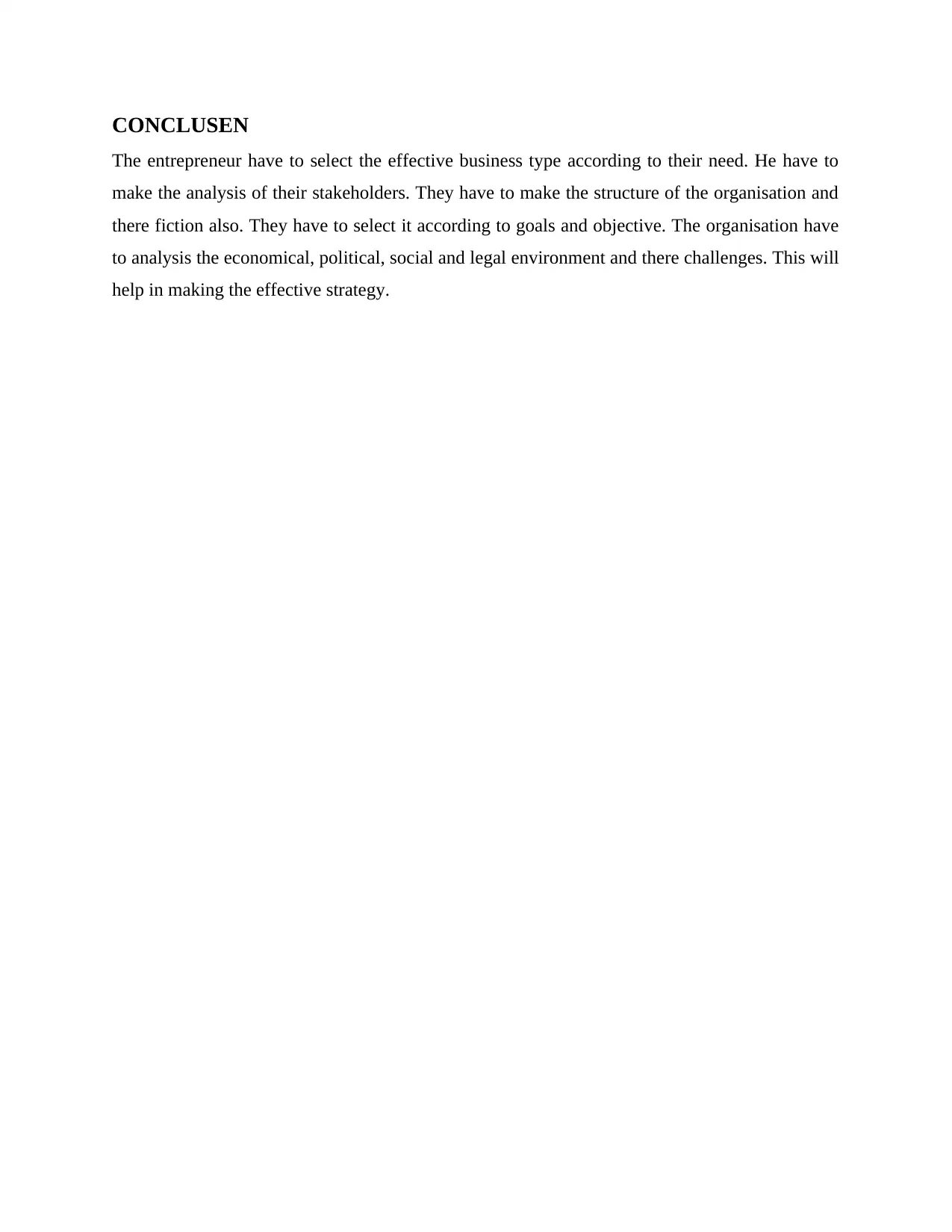
CONCLUSEN
The entrepreneur have to select the effective business type according to their need. He have to
make the analysis of their stakeholders. They have to make the structure of the organisation and
there fiction also. They have to select it according to goals and objective. The organisation have
to analysis the economical, political, social and legal environment and there challenges. This will
help in making the effective strategy.
The entrepreneur have to select the effective business type according to their need. He have to
make the analysis of their stakeholders. They have to make the structure of the organisation and
there fiction also. They have to select it according to goals and objective. The organisation have
to analysis the economical, political, social and legal environment and there challenges. This will
help in making the effective strategy.
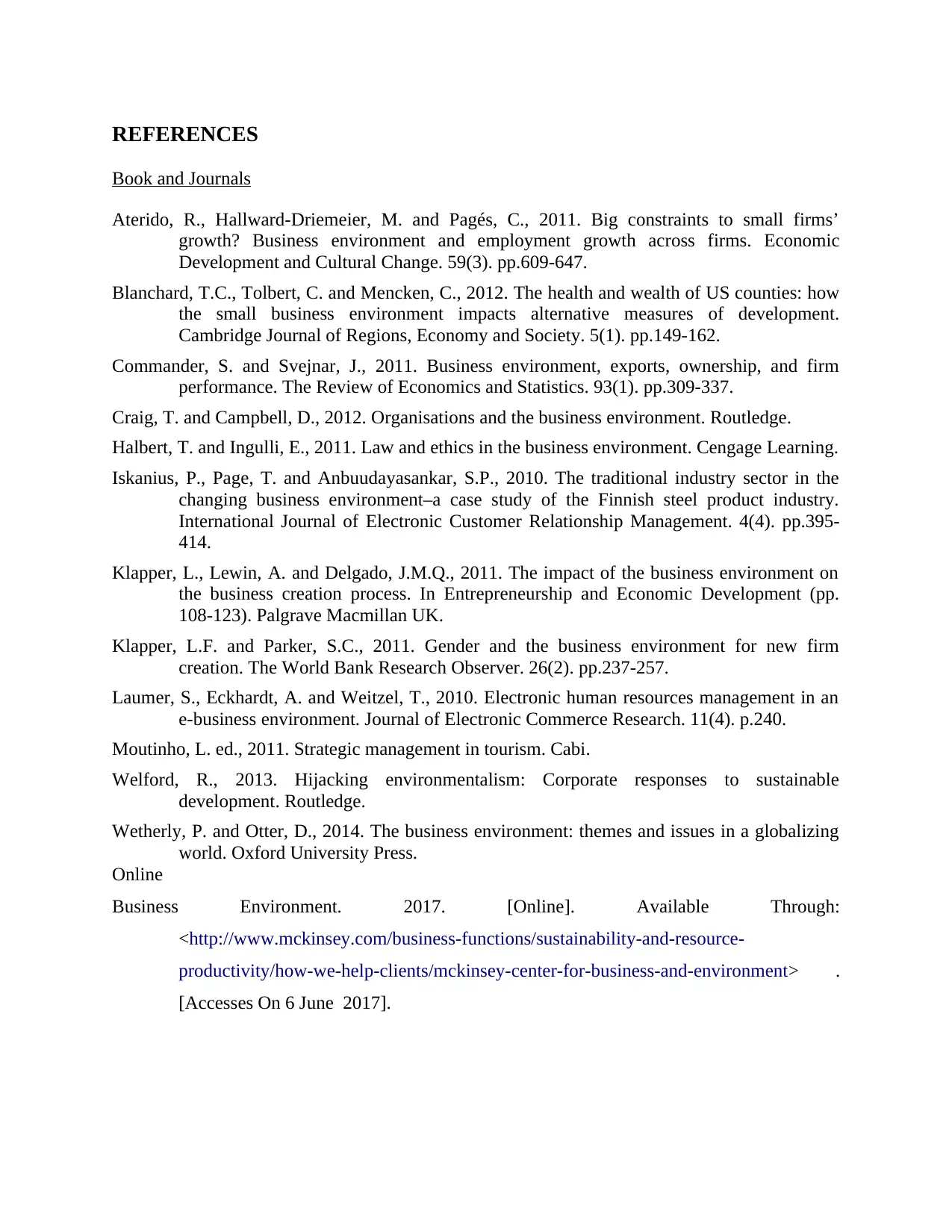
REFERENCES
Book and Journals
Aterido, R., Hallward-Driemeier, M. and Pagés, C., 2011. Big constraints to small firms’
growth? Business environment and employment growth across firms. Economic
Development and Cultural Change. 59(3). pp.609-647.
Blanchard, T.C., Tolbert, C. and Mencken, C., 2012. The health and wealth of US counties: how
the small business environment impacts alternative measures of development.
Cambridge Journal of Regions, Economy and Society. 5(1). pp.149-162.
Commander, S. and Svejnar, J., 2011. Business environment, exports, ownership, and firm
performance. The Review of Economics and Statistics. 93(1). pp.309-337.
Craig, T. and Campbell, D., 2012. Organisations and the business environment. Routledge.
Halbert, T. and Ingulli, E., 2011. Law and ethics in the business environment. Cengage Learning.
Iskanius, P., Page, T. and Anbuudayasankar, S.P., 2010. The traditional industry sector in the
changing business environment–a case study of the Finnish steel product industry.
International Journal of Electronic Customer Relationship Management. 4(4). pp.395-
414.
Klapper, L., Lewin, A. and Delgado, J.M.Q., 2011. The impact of the business environment on
the business creation process. In Entrepreneurship and Economic Development (pp.
108-123). Palgrave Macmillan UK.
Klapper, L.F. and Parker, S.C., 2011. Gender and the business environment for new firm
creation. The World Bank Research Observer. 26(2). pp.237-257.
Laumer, S., Eckhardt, A. and Weitzel, T., 2010. Electronic human resources management in an
e-business environment. Journal of Electronic Commerce Research. 11(4). p.240.
Moutinho, L. ed., 2011. Strategic management in tourism. Cabi.
Welford, R., 2013. Hijacking environmentalism: Corporate responses to sustainable
development. Routledge.
Wetherly, P. and Otter, D., 2014. The business environment: themes and issues in a globalizing
world. Oxford University Press.
Online
Business Environment. 2017. [Online]. Available Through:
<http://www.mckinsey.com/business-functions/sustainability-and-resource-
productivity/how-we-help-clients/mckinsey-center-for-business-and-environment> .
[Accesses On 6 June 2017].
Book and Journals
Aterido, R., Hallward-Driemeier, M. and Pagés, C., 2011. Big constraints to small firms’
growth? Business environment and employment growth across firms. Economic
Development and Cultural Change. 59(3). pp.609-647.
Blanchard, T.C., Tolbert, C. and Mencken, C., 2012. The health and wealth of US counties: how
the small business environment impacts alternative measures of development.
Cambridge Journal of Regions, Economy and Society. 5(1). pp.149-162.
Commander, S. and Svejnar, J., 2011. Business environment, exports, ownership, and firm
performance. The Review of Economics and Statistics. 93(1). pp.309-337.
Craig, T. and Campbell, D., 2012. Organisations and the business environment. Routledge.
Halbert, T. and Ingulli, E., 2011. Law and ethics in the business environment. Cengage Learning.
Iskanius, P., Page, T. and Anbuudayasankar, S.P., 2010. The traditional industry sector in the
changing business environment–a case study of the Finnish steel product industry.
International Journal of Electronic Customer Relationship Management. 4(4). pp.395-
414.
Klapper, L., Lewin, A. and Delgado, J.M.Q., 2011. The impact of the business environment on
the business creation process. In Entrepreneurship and Economic Development (pp.
108-123). Palgrave Macmillan UK.
Klapper, L.F. and Parker, S.C., 2011. Gender and the business environment for new firm
creation. The World Bank Research Observer. 26(2). pp.237-257.
Laumer, S., Eckhardt, A. and Weitzel, T., 2010. Electronic human resources management in an
e-business environment. Journal of Electronic Commerce Research. 11(4). p.240.
Moutinho, L. ed., 2011. Strategic management in tourism. Cabi.
Welford, R., 2013. Hijacking environmentalism: Corporate responses to sustainable
development. Routledge.
Wetherly, P. and Otter, D., 2014. The business environment: themes and issues in a globalizing
world. Oxford University Press.
Online
Business Environment. 2017. [Online]. Available Through:
<http://www.mckinsey.com/business-functions/sustainability-and-resource-
productivity/how-we-help-clients/mckinsey-center-for-business-and-environment> .
[Accesses On 6 June 2017].
⊘ This is a preview!⊘
Do you want full access?
Subscribe today to unlock all pages.

Trusted by 1+ million students worldwide
1 out of 12
Related Documents
Your All-in-One AI-Powered Toolkit for Academic Success.
+13062052269
info@desklib.com
Available 24*7 on WhatsApp / Email
![[object Object]](/_next/static/media/star-bottom.7253800d.svg)
Unlock your academic potential
Copyright © 2020–2025 A2Z Services. All Rights Reserved. Developed and managed by ZUCOL.





